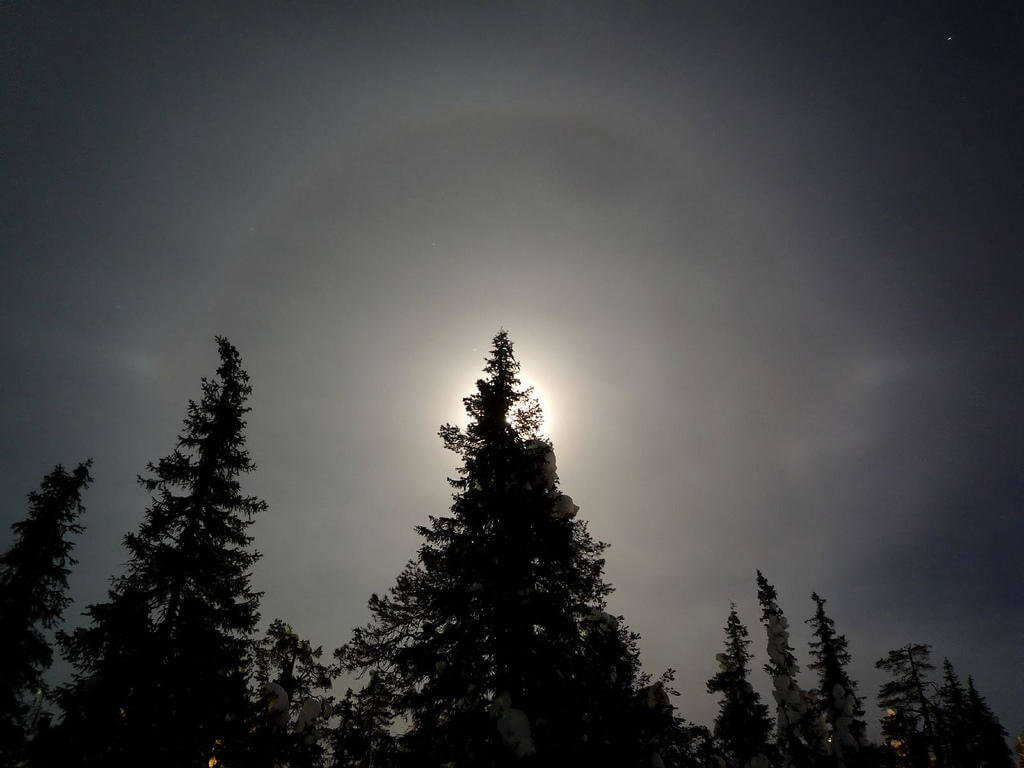Moon Dogs
by Ellie Duncan
Broadcast 12.3 & 12.8.2017 and 12.29.2020 & 1.1.2021

Photo by Timo Newton-Syms (CC 2.0).
Listen:
Moon dogs have many names: lunar halos, moon rings, or winter rings. Their scientific name is “paraselenae” and they are made visible by a combination of specific circumstances.
Tonight we’re staying in a primitive cabin, lit with the enticing orange and warmth of the small cast iron fireplace. We pull our toasted faces away from the hypnotic flame, determined to observe the night sky from the frozen surface of Lake Como, which is just down the rocky hill from the cabin. Hundreds of yards down that hill in the dark, the crunching noise of the gravely sand beneath my friends’ boots sounds inches away. The cold air carries sound with the same clarity and translucence the night sky displays.
Hiking cautiously downhill around boulders and uneven stones, I am waiting until I reach the safety of the flat shore before looking up at the sky. Walking takes all my focus in the dark, even with the generous light from the almost full moon.We make our procession towards the white void which is the snow-glazed surface of the lake. When I finally reach the icy waterside and look up I cry out, “Look at the huge ring around the moon! It’s a moon dog!”
“That’s called a moon dog?” someone asks, and we marvel at the beauty of the night sky and the halo of light around the full orb of the moon. For some reason I feel an intense need to emphasize how special the ring around the moon is: for me, for all of us, for this place.
Moon dogs have many names: lunar halos, moon rings, or winter rings. Their scientific name is “paraselenae” and they are made visible by a combination of specific circumstances. First of all, the night must be clear enough to see the moon. Simultaneously there must be a translucent layer of cirrus or cirrostratus clouds: those thin wispy clouds which take little more form than a loose brush mark across a page. Moon dogs are most commonly seen when the moon is full, or nearly so. The temperature must be cold enough to freeze the cloud’s moisture, creating hexagonal plate-shaped ice crystals that catch the moonlight. As light is refracted in millions of randomly oriented hexagonal ice crystals suspended in the atmosphere, a colorless ring becomes visible to the naked eye.
According to folklore, moon dogs are signs of approaching storms or bad weather. Because cirrus clouds often appear a few days before a large storm, this lore is scientifically sensible, although the same clouds can occur without any consistent weather change.
Every time I have seen a lunar halo, it feels like some kind of memorandum, or marking of time. I can only remember seeing moon dogs three or four other times in my life, and each time all my attention has been drawn away from my night and into the sky’s night. As the moon’s light holds the sky, I feel held too. Moon dogs have been checkpoints for me in my own story, like dog-eared pages in the paperback of my life. Seeing the sky held by the moon’s light feels like a reminder of nothing more or less than “Here you are. Here is the sky. You are alive.”
Every week since 1991, Field Notes has inquired about Montana’s natural history. Field Notes are written by naturalists, students, and listeners about the puzzle-tree bark, eagle talons, woolly aphids, and giant puffballs of Western, Central and Southwestern Montana and aired weekly on Montana Public Radio.
Click here to read and listen to more Field Notes. Field Notes is available as a podcast! Subscribe on iTunes, Google Play, or wherever you listen to podcasts.
Interested in writing a Field Note? Contact Allison De Jong, Field Notes editor, at adejong [at] montananaturalist [dot] org or 406.327.0405.
Want to learn more about our programs as well as fun natural history facts and seasonal phenology? Sign up for our e-newsletter! You can also become a member and get discounts on our programs as well as free reciprocal admission to 300+ science centers in North America!












